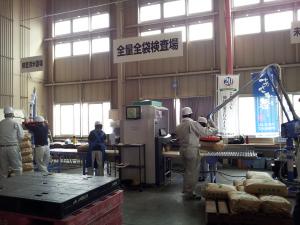| JET Study Tour Oct,2015 Member's Report05 | Name: Tiffany Kwok(Canadian) |
|---|---|
Over the course of three days this past October, I had the opportunity to participate on the JET study tour in the Aizu region of Fukushima, Japan. The tour comprised of fun tourist activities and informative study sessions about the region and its recovery efforts after the 2011 earthquake and tsunami. First, we visited JA Koriyama, where we learned about the radiation testing procedures being carried out on all rice produced in Fukushima. Every day across the prefecture, thousands of bags of rice are scanned for radiation at facilities like this one. All rice produced in Fukushima is labeled with a QR code detailing its source and the radiation data related to that particular bag of rice. Rice that register over the set safety level of radiation are destroyed. To date, less than a handful of the rice produced in Fukushima since the 2011 disaster have not met the safety standards. We also learned about radiation testing procedures on other types of produce at the Agricultural Technology Center. In the evening, we split off into groups and spent the night on farms in the Kitakata area. My group stayed with a lady that runs a flower nursery. Our host prepared us a delicious dinner of local cuisine using local produce. We enjoyed chatting with our host, helping transplant seedlings and learning about plant nurseries. Next, we learned about the Aizu Electric Power Company. Established in 2013 in response to the 2011 nuclear power plant disaster, the company is working to expand the popularity, growth and use of alternative natural energies in Fukushima. I was surprised to learn of all the numerous renewable energy projects that they are currently investing in for the future of the prefecture. Afterwards, we took a scenic drive to Minami Aizu to see traditional Japanese buildings in Oouchijuku and experience making our own soba noodles. On our last day, we learned about another form of renewable energy. The Nishiyama Geothermal Power Plant in Yanaizu uses the same sources as hot springs to generate energy. Nestled deep in the mountains, the environmentally friendly plant occupies a relatively small area and is monitored remotely with very few on-site staff. After the power plant, we visited Enzoji Temple to learn about the history of Aizu's famous red cow mascot, the Akabeko. Although the Aizu region was not directly affected by the 2011 disaster, the stigma associated with it still lingers over the entire prefecture. While the region's tourism and agricultural industries are still suffering, they are starting to recover through the efforts of the local government and communities.
| |
| Back to tour's summary |








